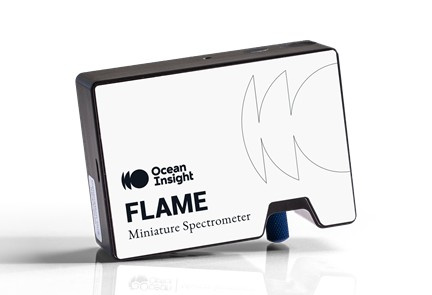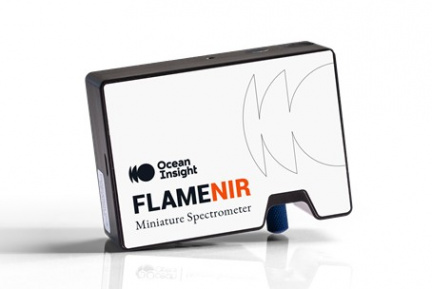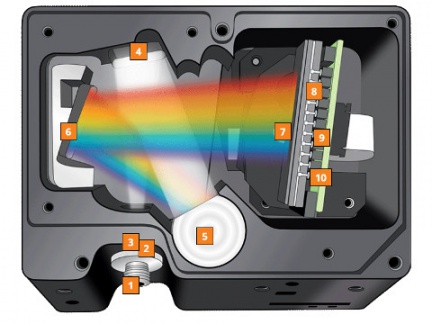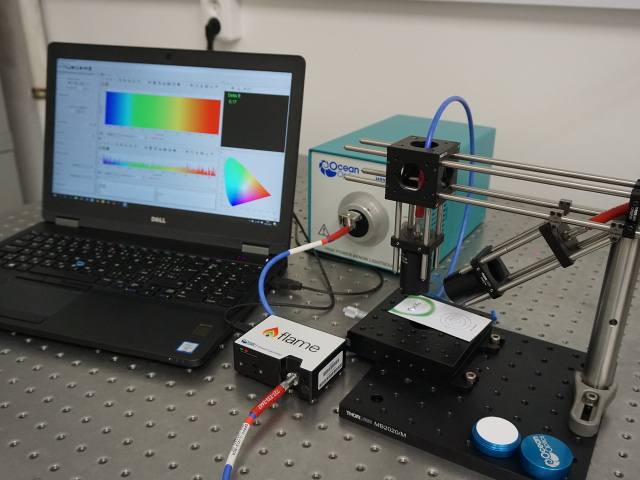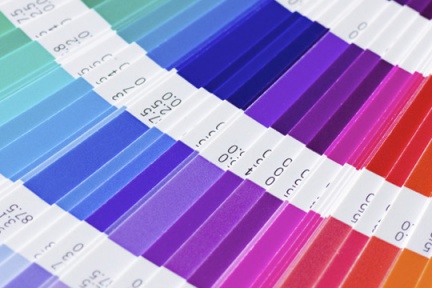For the Flame series, Ocean Insight (formerly Ocean Optics) offers pre-configured models for the most common spectroscopic measurements.
FLAME-S preconfigured models (Sony ILX511b CCD detector)
| Model |
Range (nm) |
Slit width (μm) |
Optical resolution (FWHM) |
Grating type |
Type of mirrors |
Order Sorting |
Focusing Lenses |
| FLAME-S-UV-VIS |
200-850 |
25 |
~1.5 nm |
#1 (600 vr./mm, blaze 300 nm) |
Al |
200-850 nm |
NA |
| FLAME-S-UV-VIS-ES |
L2 |
| FLAME-S-VIS-NIR |
350-1000 |
25 |
~1.5 nm |
#3 (600 vr./mm, blaze 500 nm) |
Al |
350-1000 nm |
NA |
| FLAME-S-VIS-NIR-ES |
L2 |
| FLAME-S-XR1 |
200-1025 |
25 |
~2.0 nm |
#31 (500 vr./mm, 250 nm blaze) |
Al |
200-1100 nm |
NA |
| FLAME-S-XR1-ES |
L2 |
| FLAME-S-RAD |
200-850 |
50 |
~3.0 nm |
#2 (600 vr./mm, 400 nm blaze) |
Al |
200-850 nm |
L2 |
FLAME-T preconfigured models (Toshiba TCD1304AP detector)
| Model |
Range (nm) |
Slit width (μm) |
Optical resolution (FWHM) |
Grating type |
Type of mirrors |
Order Sorting |
Focusing Lenses |
| FLAME-T-UV-VIS |
200-850 |
25 |
~1.5 nm |
#1 (600 vr./mm, blaze 300 nm) |
Al |
200-850 nm |
NA |
| FLAME-T-UV-VIS-ES |
L4 |
| FLAME-T-VIS-NIR |
350-1000 |
25 |
~1.5 nm |
#3 (600 vr./mm, blaze 500 nm) |
Al |
350-1000 nm |
NA |
| FLAME-T-VIS-NIR-ES |
L4 |
| FLAME-T-XR1 |
200-1025 |
25 |
~2.0 nm |
#31 (500 vr./mm, 250 nm blaze) |
Al |
200-1100 nm |
NA |
| FLAME-T-XR1-ES |
L4 |
FLAME-NIR (Hamamatsu G8160-03 detector)
| Model |
Range (nm) |
Slit width (μm) |
Optical resolution (FWHM) |
Grating type |
Type of mirrors |
Order Sorting |
Focusing Lenses |
| FLAME-NIR |
950-1650 |
25 |
~10 nm |
#NIR3(150 vr./mm, blaze 1100 nm) |
Au |
OF1 filter |
NA |
| FLAME-NIR+ |
970-1700 |
25 |
~10nm |
#NIR3(150 vr./mm, blaze 1100 nm) |
Au |
OF1 filter |
NA |
Thanks to the modular approach, you can customize the individual elements inside the spectrometer (diffraction grating, entrance slit, optical filters, collimating and focusing mirrors, optical lenses) to best optimize the system for your specific application.
1: Fiber optic connector
In addition to the standard SMA905 connector, a version with FC connector is also available.
2: User replaceable slot
The width of the input slit directly affects the spectral resolution of the spectrometer. The user replaceable slit set contains a total of 6 slits of different sizes (5, 10, 25, 50, 100 and 200 µm).
3: Absorption filter with top pass (longpass)
The longpass filter is used to limit the bandwidth of light entering the spectrometer or to balance the colours. It is always installed permanently and for a specific input slit.
4: Collimating mirror
The light passing through the entrance slit (and possibly the absorption filter) is directed onto the diffraction grating using this mirror. A mirror with an aluminium reflective coating is used as standard. However, a special SAG+ mirror can also be used, which absorbs almost all UV radiation.
5: Diffraction grid
The chosen diffraction grating not only determines the spectral range, but also affects the spectral resolution of the instrument. A total of 13 different gratings are available for the Flame Series spectrometer. An interactive guide can help you find the right one. During the manufacture of the spectrometer, the diffraction grating is first placed on a platform that allows it to be rotated to set the desired initial wavelength. The grating is then permanently fixed to prevent further mechanical movement.
6: Focusing mirror
The task of the focusing mirror is to focus the generated spectrum (first diffraction orders) into the detector plane. A mirror with an aluminium reflective coating is used as standard. However, a special SAG+ mirror can also be used, which absorbs almost all UV radiation.
7: Detection collection lens
The sensitivity of the spectrometer can be noticeably increased by attaching an additional cylindrical lens to the detector, which increases the collection efficiency and reduces the level of unwanted stray light. Pre-configured models that include a detector collection lens have '-ES' (Enhanced Sensitivity) in the name.
8: Detector
The correct choice of detector depends on the specific application. Three different detectors are available for the Flame series - the Sony ILX511B CCD (190-1100 nm, 2048 px, integration time 1 ms to 65 s), the Toshiba TCD1304AP CCD (190-1100 nm, 3648 px, integration time 3.8 ms to 10 s) and the Hamamatsu G8160-03 InGaAs linear sensor (900-1700 nm, 128 px, integration time 1 ms to 65 s).
9: OFLV filter to remove higher diffraction orders
OFLV (Order-sorting Filter - Longpass Variable) is applied to the detector window using a patented sputtering technology. It is used to precisely block second and third diffraction orders and thus improve the accuracy of the spectrometer.
10: Detector window (optional upgrade for UV region)
It is recommended to replace the standard BK7 borosilicate glass detector window (which starts absorbing light around 340 nm) with a quartz glass window for measurements in the UV region of the spectrum.
